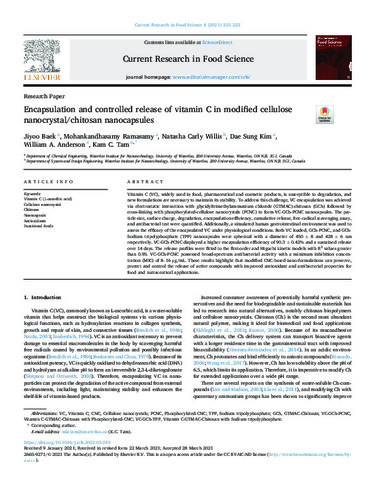| dc.contributor.author | Baek, Jiyoo | |
| dc.contributor.author | Ramasamy, Mohankandhasamy | |
| dc.contributor.author | Willis, Natasha Carly | |
| dc.contributor.author | Kim, Dae Sung | |
| dc.contributor.author | Anderson, William A. | |
| dc.contributor.author | Tam, Kam C. | |
| dc.date.accessioned | 2021-05-12 14:54:46 (GMT) | |
| dc.date.available | 2021-05-12 14:54:46 (GMT) | |
| dc.date.issued | 2021 | |
| dc.identifier.uri | https://doi.org/10.1016/j.crfs.2021.03.010 | |
| dc.identifier.uri | http://hdl.handle.net/10012/16968 | |
| dc.description.abstract | Vitamin C (VC), widely used in food, pharmaceutical and cosmetic products, is susceptible to degradation, and new formulations are necessary to maintain its stability. To address this challenge, VC encapsulation was achieved via electrostatic interaction with glycidyltrimethylammonium chloride (GTMAC)-chitosan (GCh) followed by cross-linking with phosphorylated-cellulose nanocrystals (PCNC) to form VC-GCh-PCNC nanocapsules. The particle size, surface charge, degradation, encapsulation efficiency, cumulative release, free-radical scavenging assay, and antibacterial test were quantified. Additionally, a simulated human gastrointestinal environment was used to assess the efficacy of the encapsulated VC under physiological conditions. Both VC loaded, GCh-PCNC, and GCh-Sodium tripolyphosphate (TPP) nanocapsules were spherical with a diameter of 450 ± 8 and 428 ± 6 nm respectively. VC-GCh-PCNC displayed a higher encapsulation efficiency of 90.3 ± 0.42% and a sustained release over 14 days. The release profiles were fitted to the first-order and Higuchi kinetic models with R2 values greater than 0.95. VC-GCh-PCNC possessed broad-spectrum antibacterial activity with a minimum inhibition concentration (MIC) of 8–16 μg/mL. These results highlight that modified CNC-based nano-formulations can preserve, protect and control the release of active compounds with improved antioxidant and antibacterial properties for food and nutraceutical applications. | en |
| dc.description.sponsorship | Professor K. C. Tam wishes to acknowledge the funding from CFI and NSERC.
CelluForce and AboraNano supported this CNC based research. | en |
| dc.language.iso | en | en |
| dc.publisher | Elsevier | en |
| dc.relation.ispartofseries | Current Research in Food Science;4 | |
| dc.rights | Attribution-NonCommercial-NoDerivatives 4.0 International (CC BY-NC-ND 4.0) | * |
| dc.rights.uri | https://creativecommons.org/licenses/by-nc-nd/4.0/ | * |
| dc.subject | vitamin C (L-ascorbic acid) | en |
| dc.subject | cellulose nanocrystal | en |
| dc.subject | chitosan | en |
| dc.subject | nanocapsule | en |
| dc.subject | antioxidants | en |
| dc.subject | functional foods | en |
| dc.title | Encapsulation and controlled release of vitamin C in modified cellulose nanocrystal/chitosan nanocapsules | en |
| dc.type | Article | en |
| dcterms.bibliographicCitation | Baek, J., Ramasamy, M., Willis, N. C., Kim, D. S., Anderson, W. A., & Tam, K. C. (2021). Encapsulation and controlled release of vitamin C in modified cellulose nanocrystal/chitosan nanocapsules. Current Research in Food Science, 4, 215–223. https://doi.org/10.1016/j.crfs.2021.03.010 | en |
| uws.contributor.affiliation1 | Faculty of Engineering | en |
| uws.contributor.affiliation2 | Chemical Engineering | en |
| uws.contributor.affiliation2 | Systems Design Engineering | en |
| uws.contributor.affiliation2 | Waterloo Institute for Nanotechnology (WIN) | en |
| uws.typeOfResource | Text | en |
| uws.peerReviewStatus | Reviewed | en |
| uws.scholarLevel | Faculty | en |
| uws.scholarLevel | Post-Doctorate | en |
| uws.scholarLevel | Other | en |


